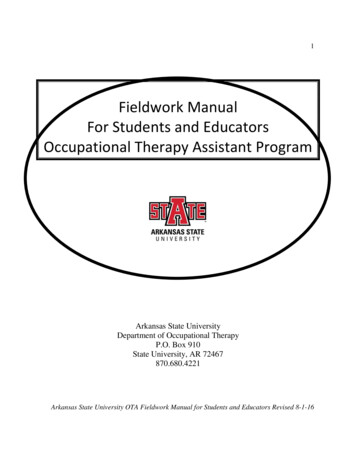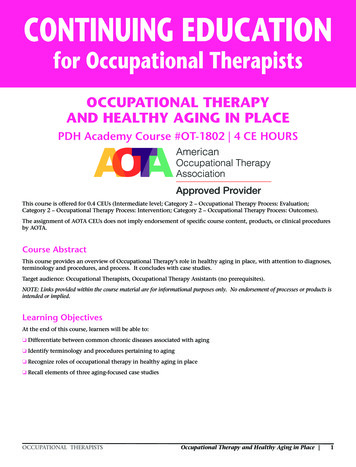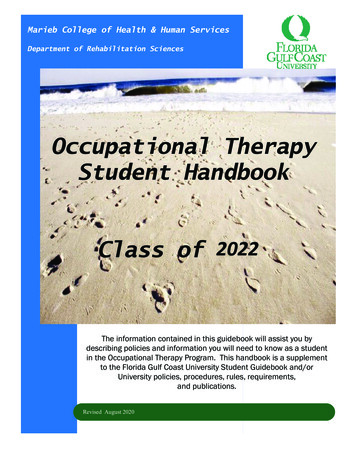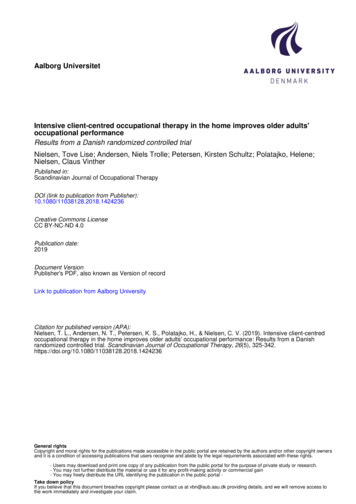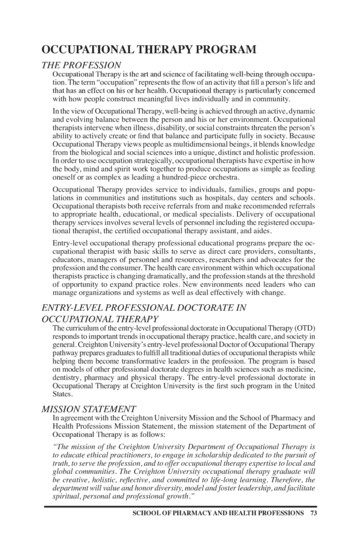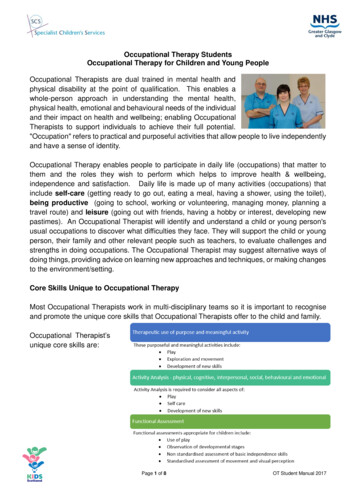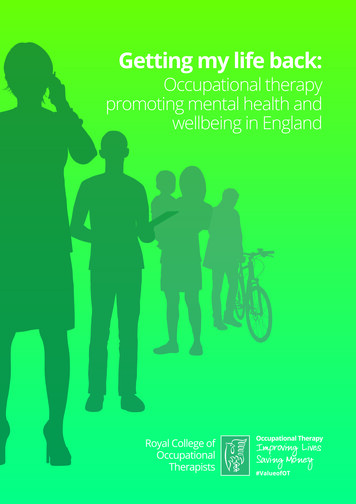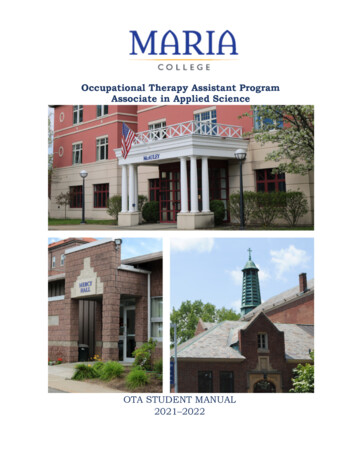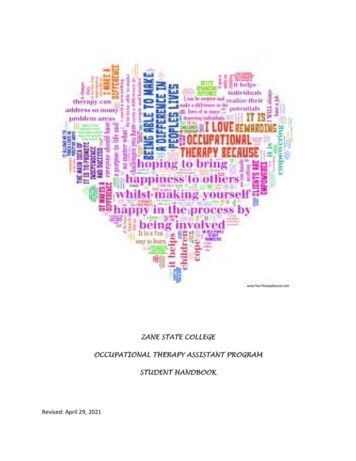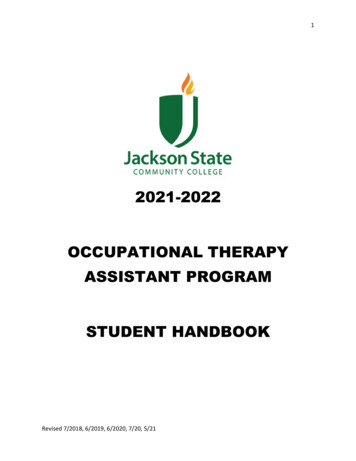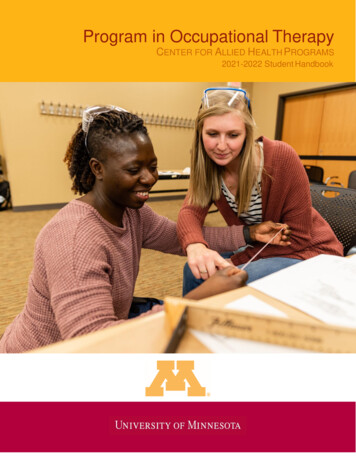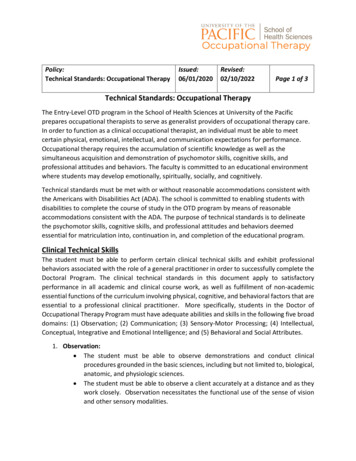
Transcription
Policy:Technical Standards: Occupational TherapyIssued:06/01/2020Revised:02/10/2022Page 1 of 3Technical Standards: Occupational TherapyThe Entry-Level OTD program in the School of Health Sciences at University of the Pacificprepares occupational therapists to serve as generalist providers of occupational therapy care.In order to function as a clinical occupational therapist, an individual must be able to meetcertain physical, emotional, intellectual, and communication expectations for performance.Occupational therapy requires the accumulation of scientific knowledge as well as thesimultaneous acquisition and demonstration of psychomotor skills, cognitive skills, andprofessional attitudes and behaviors. The faculty is committed to an educational environmentwhere students may develop emotionally, spiritually, socially, and cognitively.Technical standards must be met with or without reasonable accommodations consistent withthe Americans with Disabilities Act (ADA). The school is committed to enabling students withdisabilities to complete the course of study in the OTD program by means of reasonableaccommodations consistent with the ADA. The purpose of technical standards is to delineatethe psychomotor skills, cognitive skills, and professional attitudes and behaviors deemedessential for matriculation into, continuation in, and completion of the educational program.Clinical Technical SkillsThe student must be able to perform certain clinical technical skills and exhibit professionalbehaviors associated with the role of a general practitioner in order to successfully complete theDoctoral Program. The clinical technical standards in this document apply to satisfactoryperformance in all academic and clinical course work, as well as fulfillment of non-academicessential functions of the curriculum involving physical, cognitive, and behavioral factors that areessential to a professional clinical practitioner. More specifically, students in the Doctor ofOccupational Therapy Program must have adequate abilities and skills in the following five broaddomains: (1) Observation; (2) Communication; (3) Sensory-Motor Processing; (4) Intellectual,Conceptual, Integrative and Emotional Intelligence; and (5) Behavioral and Social Attributes.1. Observation: The student must be able to observe demonstrations and conduct clinicalprocedures grounded in the basic sciences, including but not limited to, biological,anatomic, and physiologic sciences. The student must be able to observe a client accurately at a distance and as theywork closely. Observation necessitates the functional use of the sense of visionand other sensory modalities.
The student must be able to integrate all information visually and through theother senses.2. Communication: The student must be able to communicate effectively, in a sensitive manner, andrapidly in English with clients and members of the family and the health care team. The student must be able to elicit information from clients, perceive non-verbalcommunications and describe changes in mood, activity, movement, and posture. The student must learn to modify their level of communication to be easilyunderstood by clients who are not adept in health literacy using lay terms asneeded in a respectful approachable manner. The student’s communication includes not only speech, but writing, reading,interpreting data in figures, graphs and have computer literacy. Sensory-Motor Processing and Functions: The student must have intact sensory and motor processing and functionssufficient enough to elicit information from clients by touch palpation,auscultation, and other manual and diagnostic procedures.The student will be required to coordinate both gross and fine muscular skills,balance and equilibrium and functional use of the senses of hearing, touch, andvision.The student, more specifically, must be able to exercise such fine motor skills inorder to adequately perform passive range of motion, manual muscle testing,evaluate the degree of pain and other clinical signs and symptoms.The student must exercise a level of dexterity, sensation, and visual acuity as toaccurately complete such processes as making fine measurements of physicalexamination, such as measuring blood pressure, rate of respiration and pulse, andperforming therapeutic procedures, such as the use of physical agent modalities.The student must also be able to hear sufficiently to accurately differentiateclinical findings using instruments such as stethoscopes, sphygmomanometers,and Doppler devices.The student must be able to perform methods of evaluation using a goniometer,dynamometer, and pinch gauge, and devices to evaluate light touch pressuresensation, thermal sensation and vibration using a tuning fork.The students must also be able to fabricate splints, create assistive devices anduse hand tools for therapeutic media and adaptive devices.The student must be able to move patients/clients to transfer them safely andengage in some emergency procedures such as CPR. These are also expectationsthat require a necessary level of strength.
The student must be able to move quickly and to transport themselves in amanner which provides timely response in both rehabilitation and acute caresituations.3. Intellectual, Conceptual, Integrative and Emotional Intelligence: The student must have the intellectual capacity, cognition, and emotionalintelligence necessary to analyze and resolve clinical situations and problems.These intellectual abilities include numerical recognition, measurement,calculations, clinical reasoning, analysis, judgment, synthesis, social skills andreflection. The student must be able to identify significant findings from the client's history,the physical examination, and clinical assessments, to provide a reasonable clientcentered explanation for likely causal factors and choose an appropriate plan ofcare for both short term and long-term problems that may affect participation indaily activities. The student must have the ability to incorporate new information from manysources in formulating measurable treatment plans is essential. Good judgmentin client-centered assessment, a team approach, diagnostic, and therapeuticplanning must access the best available evidence using data bases. The student must be able to identify and communicate the limits of theirknowledge to others and seek help when appropriate and needed.4. Behavioral and Social Attributes: The student must possess the emotional health required for full use of his or herintellectual abilities, exercise good judgment and carry out all responsibilities inthe education of clients, care givers and family members. The student must develop mature, sensitive, effective, and professionalrelationships with clients and members of the health care team. The student must be able to tolerate physically taxing workloads and to functioneffectively to manage their own stress levels. The student must be able to adapt to changing environments, tolerate ambiguity,demonstrate flexibility, and learn to function in the face of uncertainties inherentin the health care and health promotion delivery system. The student must have compassion, integrity, interpersonal skills, interest, andmotivation which are all personal qualities that are desired attributes in a healthprofessional and assessed during the admissions process and educationaloutcomes. Ethical StandardsA student must demonstrate the ability to reason morally and practice occupational therapy in aprofessional, ethical manner. This includes all practice and academic settings working withclients, patients, families, aggregate, community populations, faculty, peers, and all members of
the healthcare team. Professional OT practice is held to a high standard as outlined by theAmerican Occupational Therapy Code of Ethics (2015).Essential Functions of Occupational Therapy StudentsOccupational therapists employ rehabilitation and environmental strategies that contribute toself-sufficiency, social integration, improved health status, and population health of persons withchronic disease and disability. To perform these functions the student must gain the knowledge,attitudes and skills for practice that may be provided directly to individuals, or in educational orconsultative roles to clients in health care, schools, industry, and community settings.Occupational therapy students must be capable of social, cognitive, sensory and motors skillsthat will be needed in the classroom and the clinical fieldwork setting.Students with sensory and or motor limitations may be able to perform as an OT student if theypossess the ability to direct an assistant to perform the activity or use assistive technology. Ifthey are directing another, they must be able to monitor the person’s performance, perceiveobjects in the environment and observe performance. For example, a student with physicallimitations may be able to instruct another person (an assistant or aide) to perform tasks thatthey cannot do because of weakness or lack of movement. It is also possible to use compensatoryaides and assistive technology such as hearing aids or sign-language interpreters, adaptiveequipment, or computers. A student will be given the opportunity to demonstrate competencewhile using these accommodations (personal or equipment).The student must possess the following cognitive and social skills central to making decisions andinteracting with clients, families, and other professionals in the practice of occupational therapy.Cognitive skills are necessary for problem solving, clinical reasoning and judgment. Studentsmust be able to: Make meaningful and accurate observations and present findings in written reports. Receive and accurately integrate detailed and comprehensive presentations of materialfrom texts, journals, medical records and from client interviews into lesson and treatmentplans. Perform evaluations of clients with complex medical and performance problems. Analyze clinical data and accurately report results. Compare and identify differences in client’s performance. Identify and respond to factual information provided by others as well as the more subtlecues of mood, temperament, and gestures. Maintain a safe environment with the client during evaluation and intervention sessions. Maintain attention to tasks to effectively participate in class, group sessions, teammeetings and treatment of clients. Give and receive constructive feedback and adapt his or her own behavior to thesituation.
Modify treatment interventions to meet the client’s occupational needs.Demonstrate maturity in the decision making and service delivery process.Meet deadlines for assignments or tasks in both the academic and practice environment.Maintain confidentiality according to professional and institutional standards.Utilize social skills that are necessary for forming and maintaining therapeuticrelationships.Interact with faculty, other students and clients using professional language andprofessional demeanor.Participate as a member of a group and a member of a team.Ask for constructive feedback from teachers, clinical supervisors, and clients.Demonstrate flexibility and maturity in professional interactions.Impart information in such a way that others can understand and use the information.Elicit information from clients, families, practice supervisors, faculty, and peers.Verbally present observations and clinical findings with accuracy and confidence.Maintain professional and ethical standards at all times.Student Name:(Print)(Signature)University I.D. Number
prepares occupational therapists to serve as generalist providers of occupational therapy care. In order to function as a clinical occupational therapist, an individual must be able to meet certain physical, emotional, intellectual, and communication expectations for performance. . domains: (1) Observation; (2) Communication; (3) Sensory .
